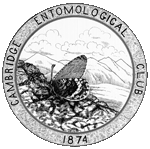
| January 2008: Psyche has a new publisher, Hindawi Publishing, and is accepting submissions |
Article beginning on page 402.
Psyche 3:402-404, 1880.
Full text (searchable PDF)
Durable link: http://psyche.entclub.org/3/3-402.html
The following unprocessed text is extracted from the PDF file, and is likely to be both incomplete and full of errors. Please consult the PDF file for the complete article.
PSYCHE.
CAMBRIDGE, MASS., SEPT.-OCT., 1882.
Commuiiicatieus, exclmng<s owd liiiofs' capia sh~id tt addresd to EDITORS OF PSYCHE, CUM- briilfi Mass, ~~ftimuft/caIfsftf for fuWicafitftt is PSYCHE must be projerly auafnticafed, and no aftony- mous arficles will bepuhiisked-
Editors and cestributors are only rssponsHltfer the ~tattm&s nxtde in their om cofftmuft Iculions. Worhs os +ts sot related to atornology will mit be ftvitwtd til PSYCHE,
For fvh of sttbscftptton nand of adverf/scftif,seeud- wrlishg columns.
PROCEEDINGS OF SOCIETIES.
CAMBRIDGE ENTOMOLOGICAL CLUB.
(Confinued from p. &.)
14 APRIL 1882.-Qth meeting.
Mr. S : H.
Scudder read a letter from Prof. J: H : Com- stock on hie recent researches in entomology. Mr. R. Hayward made a few remarks on
the food of several New England birds. He stated that his remarks were only prelimin- ary, since he lacked sufficient material to ren- der his work conclusive. Dr. H. A. Hagen expressed his surprise that no hemiptera had been discovered in the stomachs of the cliff- swallow (Peirachelidon /ua~/rons) of which three specimens had been examined, as he had taken. young nestlings of the Europenn swnllow literally filled with aphides.
Dr. Hagen showed, from an as yet unpub-
lished monograph, some plates of $.taci~a and afro$ine. He stated that all the fossil species of Psocus and Ejifsocus are similar in all respects to the modern species of those genera, while on the other hand, there is con- siderable difference between the modern and fossil species of atrojiwa. All the species of Airofos are furnished with the organs neces- sary for producing sound, but the sound, if produced, is probably not audible to oar ears ; in the other genera these organs are entirely wanting.
Mr. S : H. Scudder exhibited a specimen of ti foseil insect probably belonging to the thy- sasnru. There is apparently no head but
this part is reduced to mouth-parts which are distinct, and evidently concealed, when at rest, within the second thoracic segment, and can be thrust beyond the body. This pea- liarity is not individual, as a number of speci- mens examined by Mr. Scudder possess the same characteristic. He then showed draw- ings representing the Insect restored.
-
NOTES ON PTEROPHORIDAE OF
NORTH AMERICA.
The following references were collected, for the most part, in endeavoring to find out if the glandular hairs of some of the larvae of fterojhoridae had been studied. The notes here given cite the original and the prominent subsequent descriptions of larvae ofpierophoridae OF North America' that have been reared. To these citations are added references to published figures of different stages, to notices of food-plants of larvae, to -
localities of capture, and to observations on a few species that I have taken or reared. For the identification of the fferofkoridae of my collection I am indebted to Prof. C. H. Fernald, of Orono, Maine.
Chtysocorys festdiella Hiibn. (Wocke,
Cat. 2705). Imago figured by Walsingham
(Pteroph. Cal. and Oreg., 1880, p. 1-2, pi. I, fig. I), by whom it is said "They appear to be in ail respects the same as European spec- imen 6, having also khe same habit of frequent- ing one or more species of the genus Rubus." Found in Cal. and in Europe.
Chrysacorys felicella Wism. {Pteroph.
Cal. and Oreg., 1880, p. 2-3). Walsingham reared this species from larvae feeding on two kinds of Orthocarfus {I. c., p. 3), and fig- ures its pupa and imago (;. c., pi. 1, fig. a), Oregon.
C/irysocorys erythruedla Clemen R (Pm.
Acad. nat. sci. Phil., 1860, p. 171). Clemens (1. c.) describes the larva and pupa, and writes "The larva feeds on the fruit racemes of sumach [/?has] " in July.
Pa. ?
1 The notes are each iadepndent and can be cut and pasted on slips by those per6on.1; who thus use the Bibli- offrfiphical record.
================================================================================
d describes and figures the pupa and imago Oedema(e$korus gri
Plafyjtilus ortkocarpi Wlsm . (Pteroph. OeSema/a$har~f.t occide-ntalis Wism. ( atyftilns s&aafae Wlsrn. (Pteroph. 01.
OfSemafofhorits inipwiafus Zeiler (
3, p. 236) states that the larva feeds
raniins frateuse. Jo
g., Oct. 1831, v. 18,
. Pelarganiurn and St
================================================================================
ridge, Mass.
Some years the larvae
umerous, from late in June until 0
a to nearly destroy beds of C. tried
abundant on S
h. ~al. and Oreg., 1880, pi,.
this species is p cita kexadactyla, Linn. ( . Frisch (Besch. v. aller
================================================================================
Volume 3 table of contents